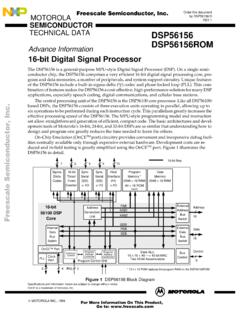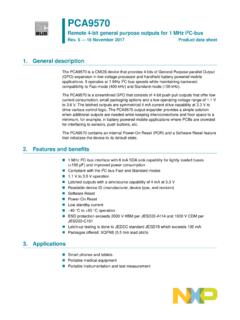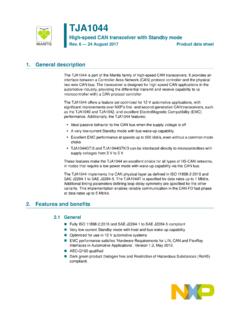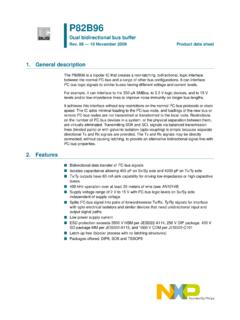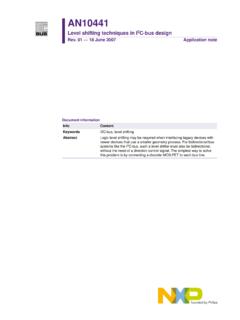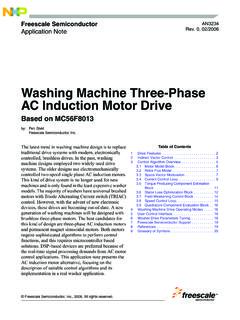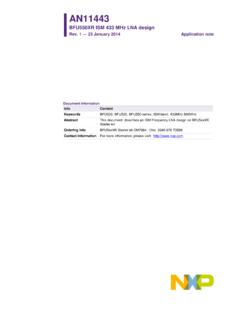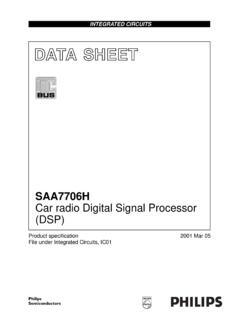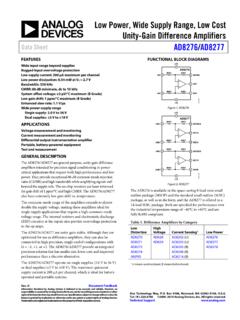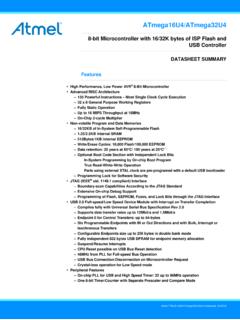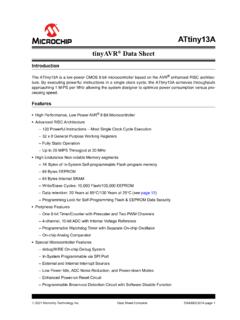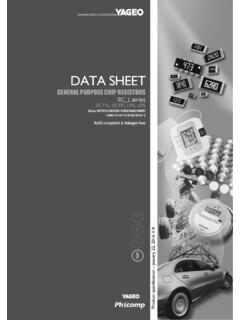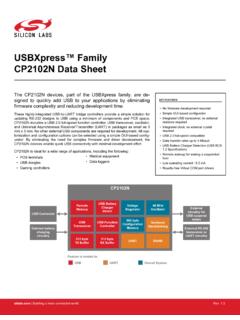Transcription of LPC1769/68/67/66/65/64/63 Product data sheet - NXP
1 1. general descriptionThe LPC1769/68/67/66/65/64/63 are ARM Cortex-M3 based microcontrollers for embedded applications featuring a high level of integration and low power consumption. The Arm Cortex-M3 is a next generation core that offers system enhancements such as enhanced debug features and a higher level of support block LPC1768/67/66/65/64/63 operate at CPU frequencies of up to 100 MHz. The LPC1769 operates at CPU frequencies of up to 120 MHz. The Arm Cortex-M3 CPU incorporates a 3-stage pipeline and uses a Harvard architecture with separate local instruction and data buses as well as a third bus for peripherals. The Arm Cortex-M3 CPU also includes an internal prefetch unit that supports speculative branching. The peripheral complement of the LPC1769/68/67/66/65/64/63 includes up to 512 kB of flash memory, up to 64 kB of data memory, Ethernet MAC, USB Device/Host/OTG interface, 8-channel general purpose DMA controller, 4 UARTs, 2 CAN channels, 2 SSP controllers, SPI interface, 3 I2C-bus interfaces, 2-input plus 2-output I2S-bus interface, 8-channel 12-bit ADC, 10-bit DAC, motor control PWM, Quadrature Encoder interface, four general purpose timers, 6-output general purpose PWM, ultra-low power Real-Time Clock (RTC) with separate battery supply, and up to 70 general purpose I/O LPC1769/68/67/66/65/64/63 are pin-compatible to the 100-pin LPC236x Arm7-based microcontroller additional documentation, see Section 19 References.
2 2. Features and benefits Arm Cortex-M3 processor, running at frequencies of up to 100 MHz (LPC1768/67/66/65/64/63) or of up to 120 MHz (LPC1769). A Memory Protection Unit (MPU) supporting eight regions is included. Arm Cortex-M3 built-in Nested Vectored Interrupt Controller (NVIC). Up to 512 kB on-chip flash programming memory. Enhanced flash memory accelerator enables high-speed 120 MHz operation with zero wait states. In-System Programming (ISP) and In-Application Programming (IAP) via on-chip bootloader software. On-chip SRAM includes: 32/16 kB of SRAM on the CPU with local code/ data bus for high-performance CPU Arm Cortex -M3 microcontroller; up to 512 kB flash and 64 kB SRAM with Ethernet, USB Host/Device/OTG, CANRev. 8 September 2020 Product data sheetLPC1769_68_67_66_65_64_63 All information provided in this document is subject to legal disclaimers.
3 NXP Semiconductors 2020. All rights data sheetRev. 8 September 2020 2 of 93 NXP SemiconductorsLPC1769/68/67/66/65/64/633 2-bit ARM Cortex-M3 microcontroller Two/one 16 kB SRAM blocks with separate access paths for higher throughput. These SRAM blocks may be used for Ethernet, USB, and DMA memory, as well as for general purpose CPU instruction and data storage. Eight channel general purpose DMA controller (GPDMA) on the AHB multilayer matrix that can be used with SSP, I2S-bus, UART, Analog-to-Digital and Digital-to-Analog converter peripherals, timer match signals, and for memory-to-memory transfers. Multilayer AHB matrix interconnect provides a separate bus for each AHB master. AHB masters include the CPU, general purpose DMA controller, Ethernet MAC, and the USB interface.
4 This interconnect provides communication with no arbitration delays. Split APB bus allows high throughput with few stalls between the CPU and DMA. Serial interfaces: Ethernet MAC with RMII interface and dedicated DMA controller. (Not available on all parts, see Table 2.) USB full-speed device/Host/OTG controller with dedicated DMA controller and on-chip PHY for device, Host, and OTG functions. (Not available on all parts, see Table 2.) Four UARTs with fractional baud rate generation, internal FIFO, and DMA support. One UART has modem control I/O and RS-485/EIA-485 support, and one UART has IrDA support. CAN controller with two channels. (Not available on all parts, see Table 2.) SPI controller with synchronous, serial, full duplex communication and programmable data length.
5 Two SSP controllers with FIFO and multi-protocol capabilities. The SSP interfaces can be used with the GPDMA controller. Three enhanced I2C bus interfaces, one with an open-drain output supporting full I2C specification and Fast mode plus with data rates of 1 Mbit/s, two with standard port pins. Enhancements include multiple address recognition and monitor mode. I2S (Inter-IC Sound) interface for digital audio input or output, with fractional rate control. The I2S-bus interface can be used with the GPDMA. The I2S-bus interface supports 3-wire and 4-wire data transmit and receive as well as master clock input/output. (Not available on all parts, see Table 2.) Other peripherals: 70 (100 pin package) general purpose I/O (GPIO) pins with configurable pull-up/down resistors.
6 All GPIOs support a new, configurable open-drain operating mode. The GPIO block is accessed through the AHB multilayer bus for fast access and located in memory such that it supports Cortex-M3 bit banding and use by the general purpose DMA Controller. 12-bit Analog-to-Digital Converter (ADC) with input multiplexing among eight pins, conversion rates up to 200 kHz, and multiple result registers. The 12-bit ADC can be used with the GPDMA controller. 10-bit Digital-to-Analog Converter (DAC) with dedicated conversion timer and DMA support. (Not available on all parts, see Table 2) Four general purpose timers/counters, with a total of eight capture inputs and ten compare outputs. Each timer block has an external count input. Specific timer events can be selected to generate DMA requests.
7 One motor control PWM with support for three-phase motor information provided in this document is subject to legal disclaimers. NXP Semiconductors 2020. All rights data sheetRev. 8 September 2020 3 of 93 NXP SemiconductorsLPC1769/68/67/66/65/64/633 2-bit ARM Cortex-M3 microcontroller Quadrature encoder interface that can monitor one external quadrature encoder. One standard PWM/timer block with external count input. RTC with a separate power domain and dedicated RTC oscillator. The RTC block includes 20 bytes of battery-powered backup registers. WatchDog Timer (WDT). The WDT can be clocked from the internal RC oscillator, the RTC oscillator, or the APB clock. Arm Cortex-M3 system tick timer, including an external clock input option. Repetitive interrupt timer provides programmable and repeating timed interrupts.
8 Each peripheral has its own clock divider for further power savings. Standard JTAG debug interface for compatibility with existing tools. Serial Wire Debug and Serial Wire Trace Port options. Boundary Scan Description Language (BSDL) is not available for this device. Emulation trace module enables non-intrusive, high-speed real-time tracing of instruction execution. Integrated PMU (Power Management Unit) automatically adjusts internal regulators to minimize power consumption during Sleep, Deep sleep, Power-down, and Deep power-down modes. Four reduced power modes: Sleep, Deep-sleep, Power-down, and Deep power-down. Single V power supply ( V to V). Four external interrupt inputs configurable as edge/level sensitive. All pins on Port 0 and Port 2 can be used as edge sensitive interrupt sources.
9 Non-maskable Interrupt (NMI) input. Clock output function that can reflect the main oscillator clock, IRC clock, RTC clock, CPU clock, and the USB clock. The Wake-up Interrupt Controller (WIC) allows the CPU to automatically wake up from any priority interrupt that can occur while the clocks are stopped in deep sleep, Power-down, and Deep power-down modes. Processor wake-up from Power-down mode via any interrupt able to operate during Power-down mode (includes external interrupts, RTC interrupt, USB activity, Ethernet wake-up interrupt, CAN bus activity, Port 0/2 pin interrupt, and NMI). Brownout detect with separate threshold for interrupt and forced reset. Power-On Reset (POR). Crystal oscillator with an operating range of 1 MHz to 25 MHz. 4 MHz internal RC oscillator trimmed to 1 % accuracy that can optionally be used as a system clock.
10 PLL allows CPU operation up to the maximum CPU rate without the need for a high-frequency crystal. May be run from the main oscillator, the internal RC oscillator, or the RTC oscillator. USB PLL for added flexibility. Code Read Protection (CRP) with different security levels. Unique device serial number for identification purposes. Available as LQFP100 (14 mm 14 mm mm), TFBGA1001 (9 mm 9 mm mm), and WLCSP100 ( mm) information provided in this document is subject to legal disclaimers. NXP Semiconductors 2020. All rights data sheetRev. 8 September 2020 4 of 93 NXP SemiconductorsLPC1769/68/67/66/65/64/633 2-bit ARM Cortex-M3 microcontroller3. Applications 4. Ordering information Ordering options eMetering Alarm systems Lighting White goods Industrial networking Motor controlTable information Type numberPackageNameDescriptionVersionLPC17 69 FBD100 LQFP100plastic low profile quad flat package; 100 leads; body 14 14 mmSOT407-1 LPC1768 FBD100 LQFP100plastic low profile quad flat package; 100 leads; body 14 14 mmSOT407-1 LPC1768 FET100 TFBGA100 plastic thin fine-pitch ball grid array package; 100 balls; body 9 9 mm SOT926-1 LPC1768 UKWLCSP100 wafer level chip-scale package; 100 balls; mm-LPC1767 FBD100 LQFP100plastic low profile quad flat package; 100 leads; body 14 14 mmSOT407-1 LPC1766 FBD100 LQFP100plastic low profile quad flat package; 100 leads.
